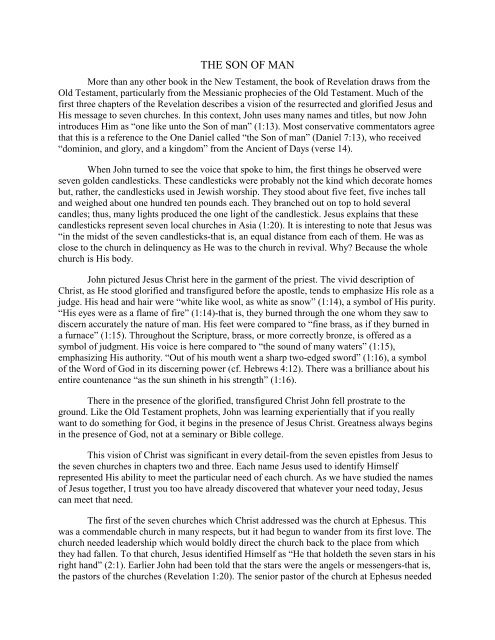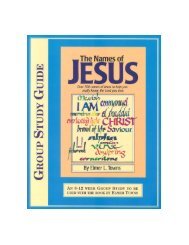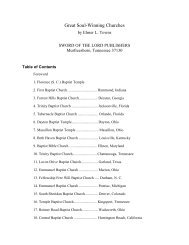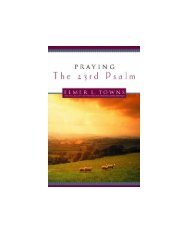The Names of Jesus - Elmer Towns
The Names of Jesus - Elmer Towns
The Names of Jesus - Elmer Towns
- TAGS
- elmer
- towns
- elmertowns.com
Create successful ePaper yourself
Turn your PDF publications into a flip-book with our unique Google optimized e-Paper software.
THE SON OF MAN<br />
More than any other book in the New Testament, the book <strong>of</strong> Revelation draws from the<br />
Old Testament, particularly from the Messianic prophecies <strong>of</strong> the Old Testament. Much <strong>of</strong> the<br />
first three chapters <strong>of</strong> the Revelation describes a vision <strong>of</strong> the resurrected and glorified <strong>Jesus</strong> and<br />
His message to seven churches. In this context, John uses many names and titles, but now John<br />
introduces Him as “one like unto the Son <strong>of</strong> man” (1:13). Most conservative commentators agree<br />
that this is a reference to the One Daniel called “the Son <strong>of</strong> man” (Daniel 7:13), who received<br />
“dominion, and glory, and a kingdom” from the Ancient <strong>of</strong> Days (verse 14).<br />
When John turned to see the voice that spoke to him, the first things he observed were<br />
seven golden candlesticks. <strong>The</strong>se candlesticks were probably not the kind which decorate homes<br />
but, rather, the candlesticks used in Jewish worship. <strong>The</strong>y stood about five feet, five inches tall<br />
and weighed about one hundred ten pounds each. <strong>The</strong>y branched out on top to hold several<br />
candles; thus, many lights produced the one light <strong>of</strong> the candlestick. <strong>Jesus</strong> explains that these<br />
candlesticks represent seven local churches in Asia (1:20). It is interesting to note that <strong>Jesus</strong> was<br />
“in the midst <strong>of</strong> the seven candlesticks-that is, an equal distance from each <strong>of</strong> them. He was as<br />
close to the church in delinquency as He was to the church in revival. Why? Because the whole<br />
church is His body.<br />
John pictured <strong>Jesus</strong> Christ here in the garment <strong>of</strong> the priest. <strong>The</strong> vivid description <strong>of</strong><br />
Christ, as He stood glorified and transfigured before the apostle, tends to emphasize His role as a<br />
judge. His head and hair were “white like wool, as white as snow” (1:14), a symbol <strong>of</strong> His purity.<br />
“His eyes were as a flame <strong>of</strong> fire” (1:14)-that is, they burned through the one whom they saw to<br />
discern accurately the nature <strong>of</strong> man. His feet were compared to “fine brass, as if they burned in<br />
a furnace” (1:15). Throughout the Scripture, brass, or more correctly bronze, is <strong>of</strong>fered as a<br />
symbol <strong>of</strong> judgment. His voice is here compared to “the sound <strong>of</strong> many waters” (1:15),<br />
emphasizing His authority. “Out <strong>of</strong> his mouth went a sharp two-edged sword” (1:16), a symbol<br />
<strong>of</strong> the Word <strong>of</strong> God in its discerning power (cf. Hebrews 4:12). <strong>The</strong>re was a brilliance about his<br />
entire countenance “as the sun shineth in his strength” (1:16).<br />
<strong>The</strong>re in the presence <strong>of</strong> the glorified, transfigured Christ John fell prostrate to the<br />
ground. Like the Old Testament prophets, John was learning experientially that if you really<br />
want to do something for God, it begins in the presence <strong>of</strong> <strong>Jesus</strong> Christ. Greatness always begins<br />
in the presence <strong>of</strong> God, not at a seminary or Bible college.<br />
This vision <strong>of</strong> Christ was significant in every detail-from the seven epistles from <strong>Jesus</strong> to<br />
the seven churches in chapters two and three. Each name <strong>Jesus</strong> used to identify Himself<br />
represented His ability to meet the particular need <strong>of</strong> each church. As we have studied the names<br />
<strong>of</strong> <strong>Jesus</strong> together, I trust you too have already discovered that whatever your need today, <strong>Jesus</strong><br />
can meet that need.<br />
<strong>The</strong> first <strong>of</strong> the seven churches which Christ addressed was the church at Ephesus. This<br />
was a commendable church in many respects, but it had begun to wander from its first love. <strong>The</strong><br />
church needed leadership which would boldly direct the church back to the place from which<br />
they had fallen. To that church, <strong>Jesus</strong> identified Himself as “He that holdeth the seven stars in his<br />
right hand” (2:1). Earlier John had been told that the stars were the angels or messengers-that is,<br />
the pastors <strong>of</strong> the churches (Revelation 1:20). <strong>The</strong> senior pastor <strong>of</strong> the church at Ephesus needed
















